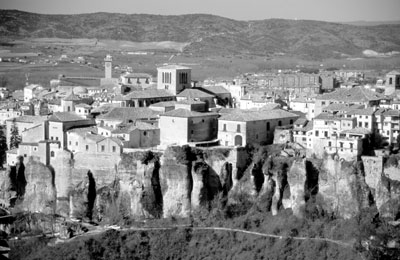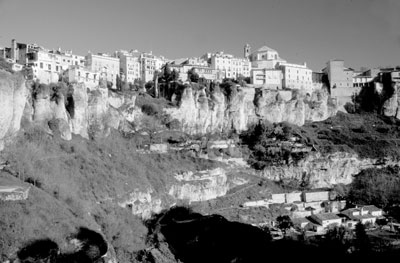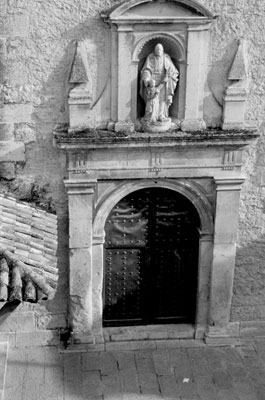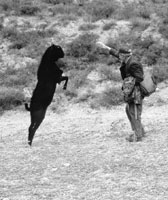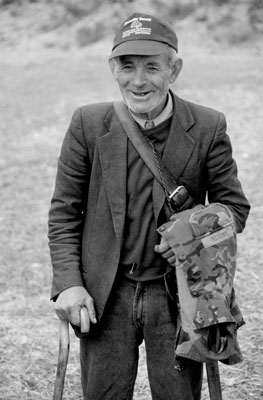Albarracín to Cuenca: With a camera over my shoulder
by Ed Kinney, part 4 of 6 on Spain
As reviewed previously, in April ’04 I traveled with six photographers on a 16-day tour with Close-Up Expeditions (800/457-9553 or www.cuephoto.com). Entitled “Spanish Explorer,” it began in Marseille, France, and ended in Granada, Spain.
In Spain, after visiting Albarracín, we proceeded to Cuenca, whose Old City is a UNESCO World Heritage Site. While both of these Spanish cities are perched on high cliffs, they are quite different in personality and appearance. Cuenca is larger, with many of its restored buildings having a flash of color, symbolizing perhaps a relatively youthful renaissance and vitality, as compared with the artistic antiquity of Albarracín.
Photographers will fall in love with Cuenca, as it proudly opens itself to exciting pictorial opportunities.
The high plains of Spain
There was always friendly chatter during our day drives between destinations, but eight sets of eyes continually looked for photographs. Entering the small village of Torre Alta, we spotted a gentleman wearing blue coveralls standing beside an old wooden shed. This presented an opportunity to practice our limited Spanish and, hopefully, get a few photographs. Once Georg Genenet saw a digital photograph of himself, he was more than obliging. By now, he should have received printed copies of the pictures.
We stopped next to photograph another of the many deserted farm buildings that appear to litter the Spanish countryside. Nearby we spied a sheepherder driving his flock, but he turned a deaf ear to us and merely shrugged his shoulders when we asked permission to photograph him. Our next encounter with a shepherd was a complete reversal, however. For an hour, Argudo chatted with us and played with his best friend, a black goat, while his dog minded the sheep. A shepherd’s life must be lonely.
By this time it was after 1 p.m., time for lunch at Restaurant Los Murales in Canete. Similar to that of most small village restaurants, the food was very good and priced reasonably. Their 3-course meal of the day, featuring salmon, cost €9 sans wine or beer. In large Spanish cities this meal would have cost at least double that.
The beautiful isolation of Cuenca
Leaving the plains, our van climbed through a hilly, roughly hewed area before we entered Cuenca. The Old City, Ciudad Antigua, rests on a cliff top guarded by two steep ravines: Hoz del Huecar and Hoz del Jucar. In the past, these ravines provided protection and isolation; now it is a wonderful, photogenic setting.
Our good fortune continued. That night’s lodging was the 16th-century Posada de San José, located a block from Cuenca’s cathedral in the Old City’s main square, Plaza Mayor de Pio XII. This posada reportedly was built as a hostel for young cathedral choirboys who were always late for practice and church. After repeatedly hitting my head on low doorways, I can believe this story.
Without unpacking, the eight of us immediately started exploring and photographing Cuenca in the late-afternoon sun, first by walking several blocks up steep Calle (Street) San Pedro to overlook Cuenca, then returning to the main square via Calle Julian Romero. The latter, a walking street, offers views of small squares, religious buildings and museums.
In Cuenca’s main square we watched locals sitting quietly or talking with friends as deepening shadows crept higher on the cathedral. The facade of this 13th- to 16th-century Norman/Gothic cathedral was rebuilt after it was destroyed by a fire in the early 20th century. Main squares are wonderful places to quietly observe the lives of locals.
The next morning, again under great photographic light, we explored more of the Old City of Cuenca. A steel walking bridge (Punta de San Pablo) over the Hoz del Huecar offers an excellent place to photograph the Old Town and especially its hanging houses, or Casas Colgadas, rising against the blue sky.
These houses were once part of a 15th-century palace, rebuilt in 1927 and later repainted. Their construction must have been difficult, as they cling to and overhang this steep ravine.
After returning to the main square, we walked through an arch in the 18th-century town hall to photograph Calle Alfonso VIII, a narrow street lined with tall houses. These 4-story-tall houses are painted in bright shades of yellows and reds, complementing their small black iron balconies. Land is at a premium for housing in Ciudad Antigua.
In mid-morning we left Cuenca and drove for several miles to an area high above this photogenic city for that “one” special photo needed to open any travelogue. At several points there we viewed fantastic panoramic scenes of Cuenca protected by its two steep ravines. Those sights and the photos we took there are the ones we most remember and cherish.
Minutiae
• Prices for the 2-star Posada de San José (phone 34 969 2113000, e-mail info@ posadasanjose.com or visit www. posadasanjose.com) were €43 (near $55) single and €70 ($90) double. A full breakfast cost €7 ($9). My single room, though small, was adequate and had a partial view of the Huecar Ravine. Access to most rooms is not handicapped friendly.
• In Plaza Mayor de Pio XII (Cuenca’s main square), we found the food at Los Arcos Restaurant good and reasonably priced at €15-€20 per person. Good beer, too!
• My favorite Spanish webpage is www.red2000.com/spain.
An individual webpage (in Spanish) for the Cuenca area of Spain is www.turalia.com.
Another source of information about Spain is www.okspain.org. Their e-mail address is oetny@tourspain.es.
• Photo tip — my most important filter in both color and B&W photography is a circular polarizing filter. It strengthens color, darkens sky and enhances clouds, especially when the camera is pointed at right angles from the sun. It also minimizes reflections when the camera is at a 45-degree angle from the reflecting surface.
Polarizing filters, however, reduce the light seen by camera meters by about 1½ stops, requiring the photographer to use either a slower shutter speed or larger aperture setting.
In my next installment of this photographic travel adventure, we’ll travel through the plains of La Mancha to Toledo, Spain, whose Old Town is another UNESCO World Heritage Site.

